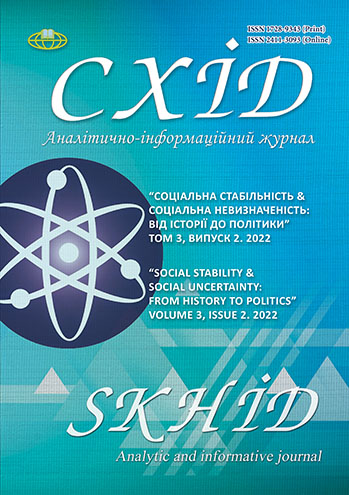“Internal emigration”: features of everyday behavior in the conditions of war
DOI:
https://doi.org/10.21847/1728-9343.2022.3(2).262630Keywords:
war of 1917-1920, urban population, everyday life, material needs, spiritual needs, social mimicry, “internal emigration”Abstract
The article reconstructs the everyday life of urban dwellers during the revolution and civil war of 1917-1920 in Ukraine. Average people include representatives of different social groups of the urban population, united by the desire to ensure their own survival by adapting to changing political and economic realities. The main models of daily practices common at that time are considered, which include a change in appearance, the use of fake documents, maximum isolation, previously unusual activities, as well as masking genuine activities in case of their forbidden nature. Appearance changed mainly by abandoning the usual clothes which made it possible to determine the social status of its wearer. The registration of all kinds of certificates transferred their owners to the “socially close” groups of the new government, and was intended to save them from various persecutions. Isolation was achieved either by a regular change of place of residence, or by the complete avoidance of any contact. The greatest ability to externally reformat their former employment was demonstrated by professional traders who tried to remain faithful to their usual business, despite all the new restrictions. The author revealed that a characteristic feature of the life of specialists who had professions in demand under any government was the long-term preservation of their usual way of life, home comfort and contentment. The specific features of the general socio-anthropological crisis of this period have been established.
Separately, the article discusses the practice of mental relaxation of citizens to preserve their illusory "small world", creating a simulation of a forever lost way of life around themselves or in the immediate environment. The author showed the consequences of applying such practices. The study of historical experience associated with periods of social uncertainty is relevant since real politics should consider the peculiarities of citizens' everyday behavior, which are mainly identical to the practices of the last century.
Downloads
References
Borisenko, M. V. (2009). Zhitlo ta pobut mіskogo naselennya Ukraїni u 20-30-kh rr. XX stolіttya. Kyiv, "Stylos" (In Ukrainian)
Central State Archive of Public Associations of Ukraine.
Central State Archive of the Supreme Authorities and Administration of Ukraine.
Chop, V. M., I.I. Lyman (2007). «Volnyy Berdyansk»: mіsto v perіod anarkhіstskogo sotsіalnogo eksperimentu (1918-1921 roky). Zaporizhzhya, "Tan-dem-U" (In Ukrainian).
Dnevnik i vospominaniya kievskoy studentki (1919 – 1920 gg.) (1924). Arkhiv russkoy revolyutsii, 15: 345 (In Russian)
Fitzpatrick, Sh. (2001). Povsednevnyy stalinizm. Sotsialnaya istoriya Sovetskoy Rossii v 30-e gody: gorod. Moskow, ROSSPEN (In Russian).
Goldenveizer, A.A. Iz kievskikh vospominaniy (1991). Arkhiv russkoy revolyutsii, 6: 364 (In Russian)
Golos truda (Nikopol). February 15, 1918. No. 1.
Gurko, V.I. Iz Petrograda cherez Moskvu, Parizh i London v Odessu (1930). Arkhiv russkoy revolyutsii, 15: 356 (In Russian)
Kievskaya mysl. September 21, 1917. No. 100.
Krasnaya smuta (2011). Moskow, Posev (In Russian).
Lebina, N.B. (2003). Povsednevnaya zhizn sovetskogo goroda 1920 - 1930 gg. URL: // http://razym.ru/naukaobraz/istoriya/ 124571-n-b-lebina-povsednevnaya-zhizn-sovetskogo-goroda-1920-1930-gg.html
Leuchtenbergsky, G.N. Vospominaniya ob «Ukraine» (1921). Berlin: "Detinets" (In Russian).
Narodnaya zhizn. Yekaterinoslavskaya zemskaya gazeta. November 17, 1917. No. 201.
Narsky, I. V. (2001). Zhizn v katastrofe: Budni naseleniya Urala v 1917-1922 gg. Moskow, Russian political en-cyclopedia (In Russian).
Obolensky, V. Krym pri Vrangele. Memuary belogvardeytsa (1927). Moskow, Leningrad, Gosudarstvennoe izdatelstvo (In Russian).
Ocherki zhizni v Kieve v 1919-1920 gg. L. L-oy (1991). Arkhiv russkoy revolyutsii, 3: 274 (In Russian)
Poslednie novosti. January 2, 1918. No. 4853.
Rappoport, Yu.K. U krasnykh i u belykh (1930). Arkhiv russkoy revolyutsii, 20: 322 (In Russian).
State Archive of the Russian Federation.
Shulgin, V.V. Dni. 1920: Zapiski (1989). Moskow, Sovremennik (In Russian).
Vernadsky, V. I. Schodenniki (2011). Vibranі nauk. pratsі akad. V.І. Vernadskogo. Kyiv, Naukova dumka, 9: 326 (In Russian)
Volnyy Yug. January 13, 1918. No. 38.
Volnyy Yug. January 19, 1918. No. 43.
Volnyy Yug. January 11, 1918. No. 36.
Yuzhnyy kray. December 22, 1918. No. 185.
Yuzhnoe slovo (Kharkov). October 30, 1918. No. 2.
Yuzhnoe slovo (Kharkov). March 17, 1918. No. 4.
Yuzhnaya zarya (Yekaterinoslav). May 10, 1918. No. 2.
Zaslavsky, D.O. Polyaki v Kieve v 1920 godu (1922). Petrograd: «Byloe» (In Russian)
Zenkovsky, V. Pyat mesyatsev u vlasti (15 maya – 19 oktyabrya 1918 g.). Vospominaniya (1995). Moskow, Krutitsy Patriarchal Compound (In Russian).
Downloads
Published
How to Cite
Issue
Section
License
Copyright (c) 2022 Вячеслав Попов

This work is licensed under a Creative Commons Attribution-NonCommercial-NoDerivatives 4.0 International License.
1. Authors bear responsibility for the accuracy of facts, quotations, numbers and names used.
2. Manuscripts are not sent back.
3. The publisher does not always agree with the authors' opinion.
4. The authors reserve the right to authorship of the work and pass the first publication right of this work to the journal under the terms of a Creative Commons Attribution-NonCommercial-NoDerivatives 4.0 International License. This license allows others to distribute (copy) the published work for non-commercial purposes, provided there is mandatory attribution to its authors and a link to the first publication in our journal.
5. The authors have the right to conclude separate supplement agreements that relate to non-exclusive work distribution in the form in which it has been published by the journal (for example, to upload the work to the online storage of the journal or publish it as part of a monograph), provided that the reference to the first publication of the work in this journal is included.

